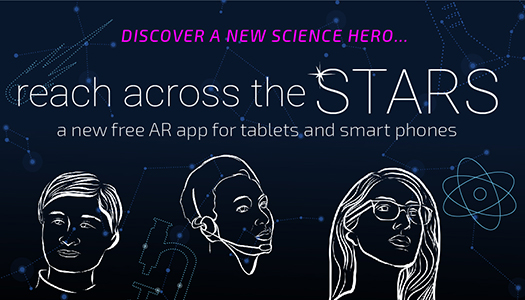For Release: April 29, 2020
Smithsonian/NASA/CXC

Now anyone can virtually "meet" women who have blazed trails in space and related science fields in a new app released through a collaboration between the Smithsonian and NASA.
The new project, "Reach Across the Stars: A Universe of Explorers," is a free augmented reality (AR) app that can be used on most AR-compatible tablets and smart phones. This app will allow users to explore the universe and unlock the often-overlooked stories of women and their contributions to space exploration and science.
Women are featured in short "stories" (one to two minutes) and longer "journeys" (five to eight minutes). Some of the women in the stories of this new app include computer scientist Grace Hopper, astronomer Nancy Roman, mathematician Katherine Johnson, physicist and chemist Marie Curie and astronauts Mae Jemison and Sally Ride.
In the app's journeys, a current scientist takes viewers into her work environment, recalling her favorite career moments as well as challenges and obstacles. Some of the feature stories combine audio interviews, video, 3D environments and 360-degree virtual reality content to let viewers peek into the worlds of these scientific heroes.
A user can explore NASA's Chandra X-ray Observatory with astronaut Cady Coleman, tour the Crab Nebula pulsar with astrophysicist Jocelyn Bell Burnell, and get a behind-the-scenes look at the Mars 2020 rover with Christina Hernandez, an instrument engineer at NASA's Jet Propulsion Laboratory.
"Space, and all science for that matter, isn't for just a certain type or category of person," said Coleman, who was aboard the shuttle mission that launched Chandra into space in 1999. "We need to empower everyone to see themselves in science, be able to make discoveries, and move our understanding of our planet and beyond."
The app also allows the user to journey to Mars in 3D with Ellen Stofan, who is the director of the Smithsonian's National Air and Space Museum, and listen to the stars with computer scientist and astronomer Wanda Diaz.
"I've been inspired on my path by learning the stories of the women like Katherine Johnson and Sally Ride who blazed trails and showed me a universe of possibilities," Stofan said. "So, it's an honor to be able to help take a new generation on a journey of discovery that can make them see they have a place exploring among the stars with this awesome project."
"Even if you haven't achieved the results that you want yet, continue to believe in your infinite potential and try to create goodness for everyone, including yourself," said Diaz, who is currently at the University of Colorado, Boulder. "In my opinion, to 'win' is not to allow anything to stop you from believing in yourself."
The app currently features over 35 women, but it will also include "serialized" content that will deliver new stories and journeys in the coming months. Users can get notifications to update the app when new material is available.
"We can't feature all of the women who have contributed significantly to our exploration of space over time," said Kimberly Arcand, visualization scientist and emerging technology lead at the Chandra X-ray Center (CXC) in Cambridge, Massachusetts, who led the project. "But we can shine a spotlight on some, and that's an important place to start."
This project is not only about women, it is created exclusively by women. In addition to Arcand, the team includes creative technologist Sasha Samochina, deputy manager of the Ops Lab at NASA's Jet Propulsion Laboratory; filmmaker and technologist Mandy Mandelstein; and designer Kristin DiVona and videographer April Jubett, both of the CXC.
The app is available for free and can be downloaded in major app stores and from chandra.si.edu/women/ar/
The project received support from the Smithsonian American Women's History Initiative, "Because of Her Story." Launched in 2018, "Because of Her Story" is one of the country's most ambitious undertakings to research, collect, document, display and share the compelling story of women.
The Chandra X-ray Observatory, one of NASA's "Great Observatories," has a special connection to the Smithsonian as its science and operations center is at the Smithsonian Astrophysical Observatory in Massachusetts. The Marshall Space Flight Center in Huntsville, Alabama, manages the Chandra X-ray Center on behalf of NASA.
Media Contacts:
Megan Watzke
Chandra X-ray Center, Cambridge, Massachusetts
617-496-7998
mwatzke@cfa.harvard.edu


